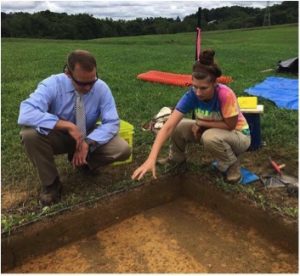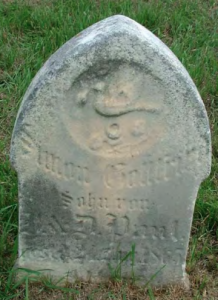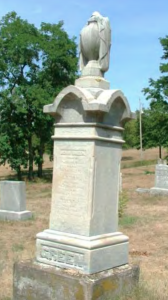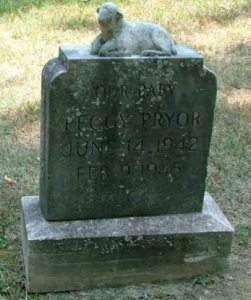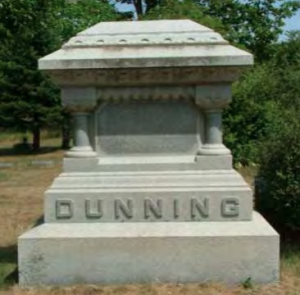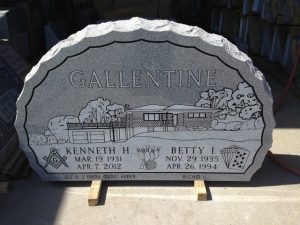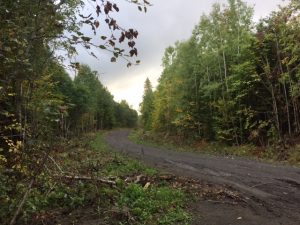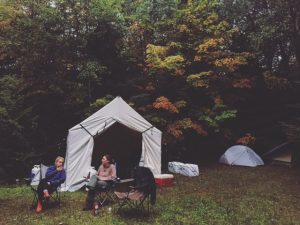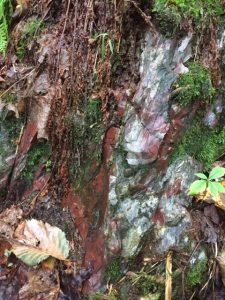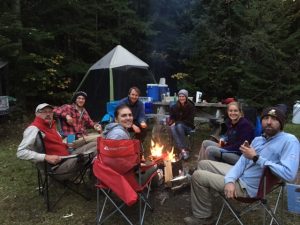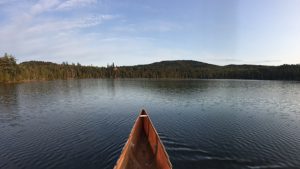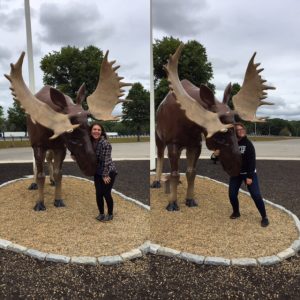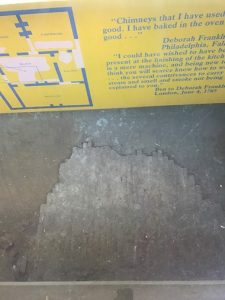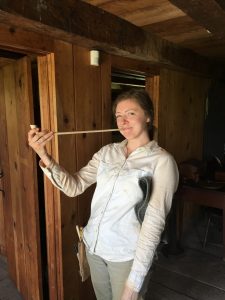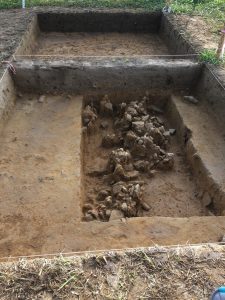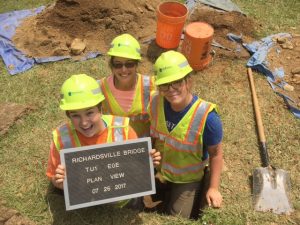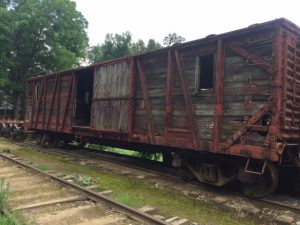By : Angela Jaillet-Wentling
From underneath a rusty 1927 Studebaker coupe car (an antique even in my youth) frame, my Papa called out to myself and my brother, “Can one of you kids hand me a the flat-head screwdriver with the stubby handle?” At the ripe old ages of six and four, we may very well have handed him a pair of pliers for all we knew. He’d roll out on his card dolly with a smile, accuse us of being monkey wrenches, show us the tool he’d meant and head back under an engine most people had given up on fifty years prior. What I’d learned from my Papa, even as I spent more time playing with and picking on my younger brother, was that every job has a tool and some tools are more appropriate than others.
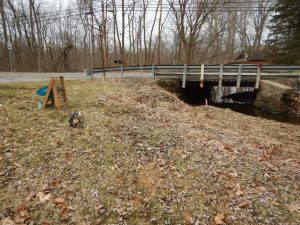
Photo 1. Shovel testing /Phase I archaeological survey, Lawrence County, Pennsylvania. Courtesy Angie Jaillet-Wentling (2017).
One of the first things about archaeology that I found re latable was this idea. I also like dirt, so it’s worked out well as a life/career choice for me! I began my career in Cultural Resources Management (CRM) in transportation through an internship with the Pennsylvania Department of Transportation (PennDOT). As a note though, when I told my Papa that I wanted to be an archaeologist and there were jobs for in places like PennDOT, he laughed and hit me with one of the biggest myths I face as a transportation archaeologist “So, you’re going to hold up progress on the highways?!” Another thing my Papa taught me is that you can face almost anything with humor and a quick response. Being new to the profession, I don’t know that I had a good response to his question other than to laugh, give him a mock grumpy look, and say it wasn’t true. This is still true, but now I can tell him we rarely “hold up” a project and that we’re there to ensure that we don’t inadvertently lose out on our shared heritage by pushing projects through without consideration.
As a PennDOT archaeologist, we’re hired as historic preservation specialists and called Cultural Resource Professionals (CRPs) (https://www.paprojectpath.org/penndot-crm/home). We help guide the implementation of PennDOT’s cultural resources program and the ways in which the individual engineering districts navigate the Section 106 (of the National Historic Preservation Act, as amended [1966, 2016]) (http://www.achp.gov/nhpa.pdf) process and how it may affect the overarching National Environmental Policy Act (NEPA) (1969) (https://www.whitehouse.gov/sites/whitehouse.gov/files/ceq/NEPA_full_text.pdf), process. On a more localized level, what this means is that I work as one part of a team which includes myself covering below-ground cultural resources and my counterpart, an architectural historian, covering the above-ground cultural resources realm. We attend design field views early in the project planning process, provide guidance as to what studies may be needed, sometimes performing these studies ourselves, and ensure that each project follows the process in the most efficient way possible. We’re responsible for Findings of Effect or the determination of whether a project’s activities will affect cultural resources and, if so, how PennDOT can mitigate for that impact.
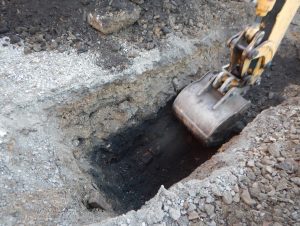
Photo 2. Backhoe Sounding of Ground-Penetrating Radar survey, Fayette County, Pennsylvania. Courtesy Angie Jaillet-Wentling (2017).
That all sounds awfully convoluted and legal, and it is, but it’s also done in equal parts archaeology technical know-how and documentation (findings, reports, and even public outreach). On any given day, I can be found roadside wielding a soil probe or shovel to determine the extent of previous disturbances (Photo 1) or monitoring the removal of modern overburden by a backhoe to ground-truth the results of a ground-penetrating radar survey (Photo 2) or floating in a kayak in freezing weather to delineate canal resources (Photo 3) or pecking away on my keyboard to notify Federally-Recognized Tribes and Nations across the nation of project status or preparing legally-binding programmatic agreements. We conduct background research on our projects to provide the best guidance possible and sometimes this gives us a better idea of the methods we’d like to use to investigate differing project areas and potential cultural resources.
Preparing haphazardly for this blog post, I asked Gen Everett what she’d like me to write about. She though that I should discuss what I do as a CRP and possibly advice for graduates heading towards CRM. There’s a joke archaeologists like to tell about classifying artifacts, you’re either a lumper or a splitter – as in you either associate or you differentiate the different characteristics of artifacts. I’m going to lump what I find most critical to completion of my daily duties and advice into one basic idea: know your tools and to do this ask questions!
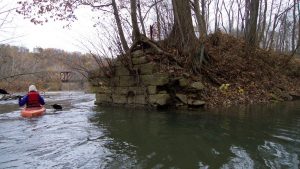
Photo 3. Canal survey of a portion of the Kiskiminetas River, Westmoreland and Armstrong Counties, Pennsylvania. Left: Angie Jaillet-Wentling. Middle Background: Railroad Trestle. Right: Canal Towpath Bridge Abutment. Courtesy Don Burden (2017).
Archaeology and CRM is filled with resources (and not just the cultural/archaeological/historical kind) in both its practitioners and its methodologies. Familiarize yourself with different methods of investigation so that you can develop a nuanced and effective approach to identifying and evaluating cultural resources that may be impacted by a project. This means that you might need to move beyond the standard shovel testing to remote sensing methods to backhoe trenches. You should be comfortable with the different options, so that you’re confident in choosing the most appropriate tool for the task. To be comfortable and confident, familiarize yourself with the methods and the people that know them best understanding that you might not be the expert, but you know who is. You can’t come by this knowledge without putting in the research and asking questions!
Once you get to the point where you have something to impart, be it knowledge or support, it probably doesn’t hurt to share it with others. I think this applies to research and experience. What’s the use in learning about our history, if you can’t use that to help others increase awareness? Publish and present what you can. Graduate students in the future will likely cite it or critique it, but it furthers your field of study. I was very fortunate to have early and often mentorship from PennDOT, in the form of the usually laughing and story-telling, Mr. Joe Baker. I count myself even more fortunate in my latest stint as a PennDOT CRP, because we get to work with and help mentor the PennDOT Highway Archaeology Survey Team (PHAST) (https://iblog.iup.edu/trowelsandtribulations/tag/phast/, https://iblog.iup.edu/trowelsandtribulations/2017/08/31/my-summer-as-a-phast-intern/, or https://iblog.iup.edu/trowelsandtribulations/2016/07/13/pennsylvania-highway-archaeological-survey-team-midseason-update/comment-page-1/). It’s a joy to hear their questions, answer what I can, and pose some back to them.
Angie Jaillet-Wentling
Angela Jaillet-Wentling, M.A., RPA | Historic Preservation Specialist
PA Department of Transportation
Bureau of Project Delivery | Cultural Resources Unit
CRP Archaeologist Engineering Districts 12-0/11-0

